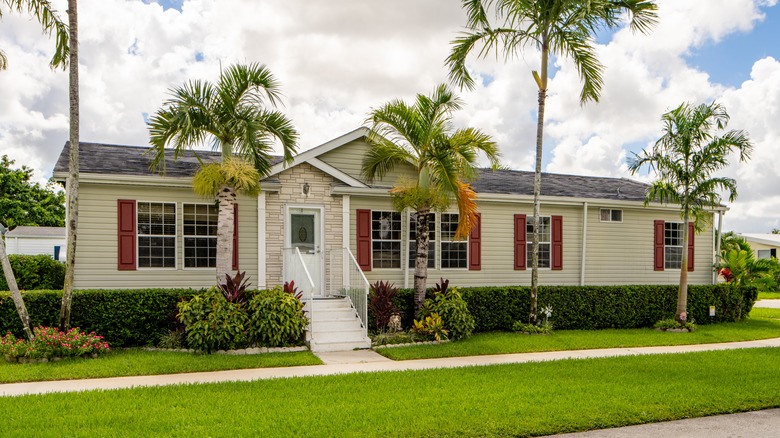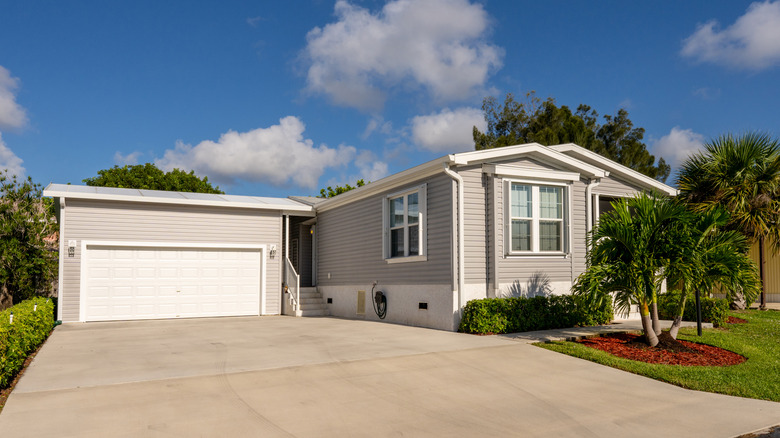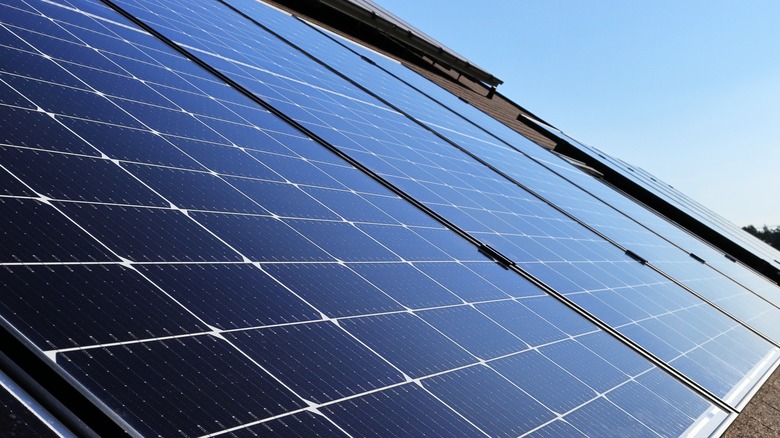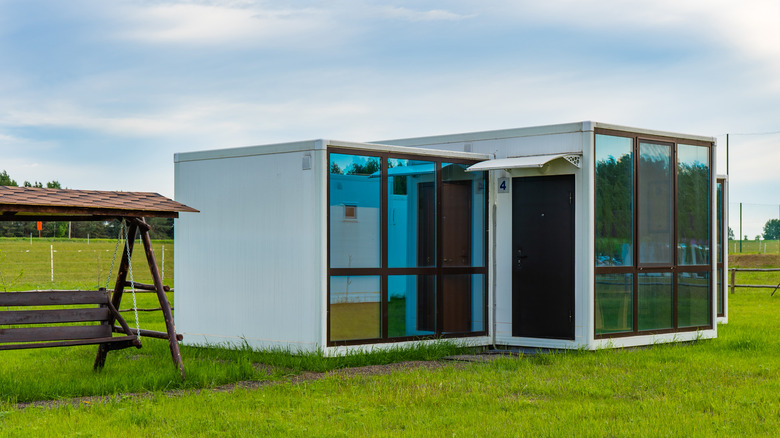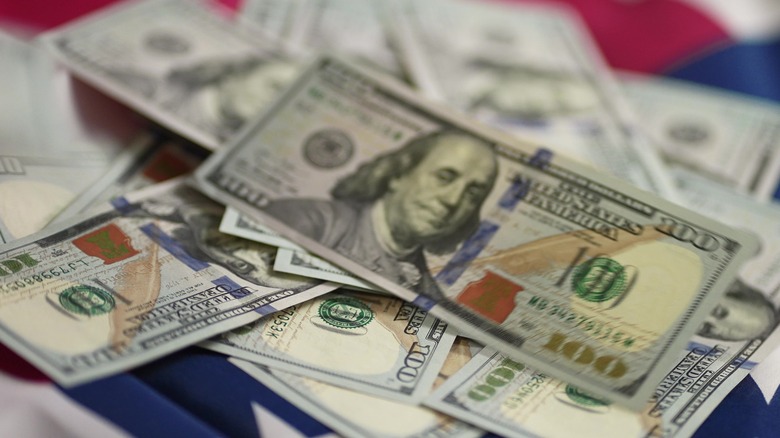What You Should Know About Manufactured Homes
The housing market has been doing some funky stuff these past few years. According to Bloomberg, the pandemic spiked a never-ending housing shortage, triggering outrageous bidding wars with astronomical numbers. Then came the increase in mortgage rates and interest rate hikes; inflation hasn't been helping, either, writes Nerd Wallet. It's no wonder first-time home buyers have had it tough. While the typical housing market has been acting wonky, the manufactured housing industry has been doing quite well, as noted on Stacker. This market saw more shipments in 2022 since its last rise to prominence in 2006.
A manufactured home is a mobile home built after 1976, notes the insurance company, GEICO. Manufactured homes follow a stricter set of building guidelines that are more in line with the modern on-site houses of the present, per Clayton Homes. Today's manufactured homes also called prefabricated or prefab homes, are comparable to on-site homes but at a fraction of the price. Yet while they may be the new "it" abodes, we've pulled together a few of the more essential things you should know before delving into the wonderful world of modular living.
They're affordable
According to The Motley Fool, the average price for a home in the United States is around $354,649. But this price also obviously varies from state to state. In case you're wondering, the winner of the lowest in West Virginia, where the average cost for a single-family home is $137,286. If you're looking for a non-beachfront, less-than-1,000-square-feet home in Hawaii, you can expect to pay a cool $1,038,544. It goes without saying that being a first-time homebuyer will put a dent in your wallet.
But that changes if you are looking into purchasing a manufactured home. Money Crashers estimates $100 and $220 per square foot for a prefab home, with the national average hovering around $180,000. That doesn't consider all the other fees associated with purchasing one of these bad boys, but it gives you a good idea of how much you would need to get the ball rolling on your homeownership status.
They're energy efficient
Never fear if you're worried that prefab homes aren't as energy-savvy as their built-on-site counterparts. In 1976, the government passed the National Manufactured Housing Construction and Safety Standards Act of 1974, per NewHomeSource. This law imposed stricter regulations for building prefabricated and mobile homes and dubbed any mobile home built after 1976 a manufactured home. These new homes were also built on a permanent chassis, which meant they were there for good once they were delivered and completed.
Per The U.S. Department of Energy, just because your home is a manufactured or prefab home doesn't mean you can't have all the technological eco upgrades that on-site houses do. So if you want photovoltaic windows or sunspace, you can have that built in. A geothermal heat pump or solar water heater? You can do that, too. The only reason people think manufactured homes are "less than" is the decades-old stigma surrounding them, writes Honolulu Civil Beat. It's time to let these stereotypes go. Prefabricated houses may be affordable, but that doesn't mean you're investing in a home from yesteryear. This is the future, and the future is green. So why shouldn't you be able to have a home that saves you green in more than just purchase price?
They're customizable
Part of the beauty of building a prefab home is the ability to customize it as much as you'd like. Like any house, you can always stick with a predesigned home, writes BuildGreenNH. These homes are built in a specific style; whether it be farmhouse, colonial, ranch style, or contemporary, there's pretty much something for everyone. It's also possible to build up and out, adding a garage, laundry room, or patio deck. If you're considering starting a family one day, you can add a second story. Are floor-to-ceiling windows your thing? Go forth and install.
According to the website Design. Build. Modular, there's a particular order in which you should create your new home. You start with the exterior and figure out the architectural style (as noted above), color, porch layout, and windows. Then you get to tackle the interior, which includes the entire floor plan. The most crucial step is to write down your ideas, aspirations, and any little additions you'd like.
You'll probably run into hidden costs
You'd think you'd be paying an all-inclusive price when you throw down for a brand new, made-to-order off-site abode. Unfortunately, there are more than a handful of extra, unexpected costs you'll pay once your home is delivered to its final destination. According to the website Modular Today, when you purchase a prefab home, you'll be interacting with at least three different groups of individuals: the dealer or company, the general contractor, and the bank. On top of that, each party has its own set of rules and regulations regarding payment for services rendered.
You might save a few dollars when you buy a built-off-site home, but remember that your purchase will still need to be delivered to a location. You'll be expected to finance this transportation because it isn't typically built into the cost of the house. Transportation insurance is another non-negotiable because the last thing you want is a piece of your living room to go missing. Once the details of your fab prefab have arrived, the general contractor will need to put the whole thing together. That means you'll be expected to pay for any extra materials and, of course, hired help. HOMEiA also warns that if there are any home additions (air conditioning, porches, etc.), or site work, you're in charge of covering that, too.
You'll still have a landlord and pay rent
As previously mentioned, manufactured homes differ from mobile homes in that, once delivered, they're not going anywhere. You indeed own the house, but it's another story for the land on which it sits. According to this 2020 fact sheet from Manufactured Housing, 63% of homeowners of prefabricated houses end up living on land they purchased themselves, while the other 37% will move into a mobile home park or community. Homeowners who buy and own their land and their home can expect to pay real estate taxes annually to their local government. Those individuals who don't own land, but own their homes, should also expect to pay property taxes.
On top of that, there's a pesky little fee that you'll have to pay for the land where your home will be sitting, which can either be rented or leased, depending on the property owners. But the worst part is that if you live in a community or park, you're at the mercy of whoever owns it. If a corporation or out-of-state institutional investors own your community plots, there's a good chance that your rent and other implemented fees will probably increase.
